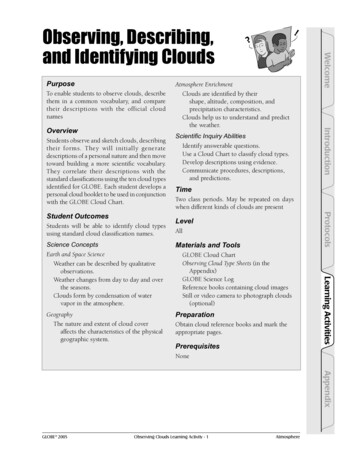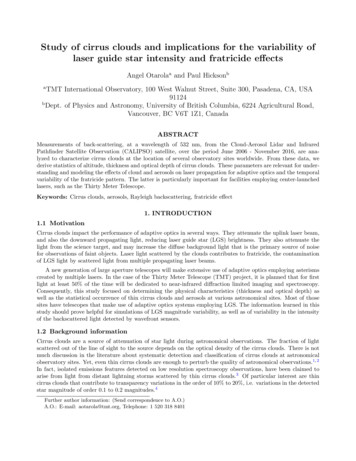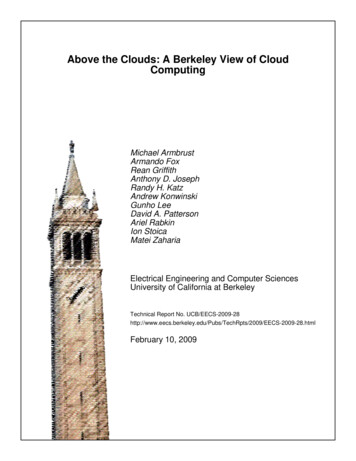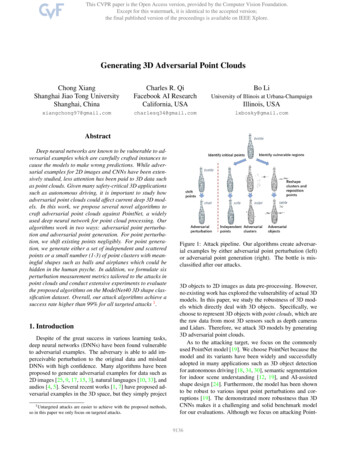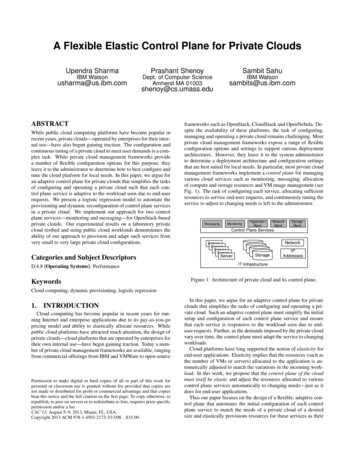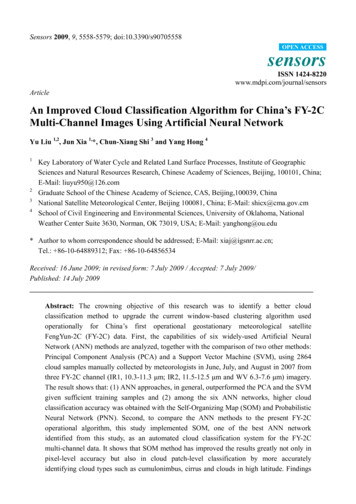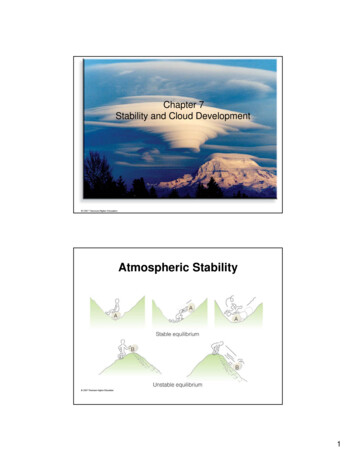
Transcription
UC BerkeleyAbove the Clouds:A Berkeley View of Cloud ComputingArmando Fox and a cast of tens, UC Berkeley Reliable Adaptive Distributed Systems LabUSENIX LISA 2009 20091Image: John Curley http://www.flickr.com/photos/jay que/1834540/
Datacenter is new “server” “Program” Web search, email, map/GIS, “Computer” 1000ʼs computers, storage, networkWarehouse-sized facilities and workloadsNew datacenter ideas (2007-2008): truck container (Sun),floating (Google), In Tents Computing (Microsoft) How to enable innovation in new services without firstbuilding & capitalizing a large company?photos: Sun Microsystems & datacenterknowledge.com2
RAD Lab 5-year MissionGoal: Enable 1 person to develop, deploy, operatenext -generation Internet application Key enabling technology: Statistical machine learning– management, scaling, anomaly detection, performance prediction. interdisciplinary: 7 faculty, 30 PhDʼs, 6 ugrads, 1sysadm Regular engagement with industrial affiliates keeps us fromsmoking our own dope too often3
How we got into the clouds Theme: cutting-edge statistical machinelearning works where simple methods fail– Resource utilization prediction– Adding/removing storage bricks to meet SLA– Console log analysis for problem finding Sponsor feedback: Great, now show thatit works on at least 1000ʼs of machines4
Utility Computing to theRescue: Pay as you Go Amazon Elastic Compute Cloud (EC2) “Compute units” 0.10-0.80/hr. 0.085/hr & up– 1 CU 1.0-1.2 GHz 2007 AMD Opteron/Xeon core“Instances”PlatformCoresMemoryDiskSmall - 0.085 / hr32-bit11.7 GB160 GBLarge - 0.34/ hr64-bit47.5 GB850 GB – 2 spindles XLargeN - 0.68/ hr 64-bit815.0 GB 1690 GB – 3 spindlesOptions.extramemory,extra CPU,disk, . No up-frontcost, nocontract,noextraminimum storage ( 0.15/GB/month) network ( 0.10-0.15/GB external; 0.00 internal) Everything virtualized, even concept ofindependent failure5
Cloud Computing is Hot *sigh*“.weʼve redefined Cloud Computing toinclude everything that we alreadydo. I donʼt understand what wewould do differently . other thanchange the wording of some of ourads.” Sept. 2008“Weʼve been building data center afterdata center, acquiring application afterapplication, .driving up the cost oftechnology immensely across theboard. We need to find a moreinnovative path.” Sept. 20096
A Berkeley View ofCloud Computingabovetheclouds.cs.berkeley.edu 2/09 White paper by RAD Lab PIʼs/students Goal: stimulate discussion on whatʼs new– Clarify terminology– Quantify comparisons– Identify challenges & opportunities UC Berkeley perspective– industry engagement but no axe to grind– users of CC since late 20077
Rest of talk1. What is it? Whatʼs new?2. Challenges & Opportunities3. “We should cloudify ourdatacenter/cluster/whatever!”4. Academics in the cloud8
1. What is it? Whatʼs new? Old idea: Software as a Service (SaaS),predates Multics New: pay-as-you-go, utility computing– Illusion of infinite resources on demand (minutes)– Fine-grained billing: release donʼt pay– No minimum commitment– Earlier examples (Sun, Intel): longercommitment, more /hour, no storage9
Cloud Economics 101 Cloud Computing User: Static provisioningfor peak - wasteful, but necessary for SLAMachinesCapacity CapacityDemandDemandTimeTime“Statically provisioned”data center“Virtual” data centerin the cloudUnused resources10
Cloud Economics 101MachinesCapacityDemandEnergy Cloud Computing Provider: Could saveenergyCapacityDemandTimeTime“Statically provisioned”data centerReal data centerin the cloudUnused resources11
Back of the envelope Server utilization in datacenters: 5-20%– peaks 2x-10x average C cost/hr. to use cloud (.085 for AWS) B cost/hr. to buy server– 2K server, 3-year depreciation: 0.076 HW savings (peak/average util.) – (C/B)– in this example, save if peak 1.1x average– can also factor in network & storage costs Caveat: IT accounting often not so simple12
Risk of Overprovisioning Underutilization results if “peak” predictionsare too optimisticCapacityResourcesUnused resourcesDemandTimeStatic data center13
ResourcesResourcesRisks of Under Provisioning3Lost revenueResourcesDemand3Demand21Time (days)Capacity21Time (days)CapacityCapacityDemand21Time (days)Lost users314
Risk Transfer vs. CapEx/OpEx Over long timescales, a dollar is a dollar CC is not necessarily cheaper, esp. if youhave steady, known capacity needs But risk transfer opens fundamentally newopportunities.15
Risk Transfer: new scenarios “Cost associativity”:1K servers x 1 hour 1 server x 1K hours– Washington Post: Hillary Clintonʼs travel docsposted to WWW 1 day after released– RAD Lab: publish results on 1,000 servers Major enabler for SaaS startups– Animoto Facebook plugin traffic doubledevery 12 hours for 3 days– Scaled from 50 to 3500 servers– .then scaled back down16
Why Now (not then)? Build-out of extremely large datacenters(10,000s commodity PCs) .and how to run them– Infrastructure SW: e.g., Google File System– Operational expertise: failover, DDoS, firewalls.– economy of scale: 5-7x cheaper than provisioningmedium-sized (100s/low 1000s machines) facility Necessary-but-not-sufficient factors– pervasive broadband Internet– Commoditization of HW & Fast Virtualization– Standardized (& free) software stacks17
UC Berkeley2. Challenges & OpportunitiesA subset of whatʼs in the paperBoth technical & nontechnical18
Classifying Clouds Instruction Set VM (Amazon EC2)Managed runtime VM (Microsoft Azure)Framework VM (Google AppEngine, Force.com)Tradeoff: flexibility/portability vs. “built in”functionalityLower-level,Less managedEC2Higher-level,More managedAzureAppEngine,Force.com19
Lock-in/business continuityChallengeAvailability /business continuityOpportunityMultiple providers & datacentersOpen API’s Few enterprise datacentersʼ availability is as good “Higher level” (AppEngine, Force.com) vs. “lowerlevel” (EC2) clouds include proprietary software richer functionality, better built-in ops support– structural restrictions FOSS reimplementations on way? (eg AppScale)20
Data lock-inChallengeData lock-inOpportunityStandardization FOSS implementations of storage (egHyperTable) 10/19/09: Google Data Liberation Front21
Data is a Gravity WellChallengeData transferbottlenecksOpportunityFedEx-ing disks,Data Backup/Archiving Amazon now provides “FedEx a disk”service and hosts free public datasets to “attract”cycles22
Data is a Gravity WellChallengeScale-up/scale-downstructured storageOpportunityMajor research opportunity Profileration of non-relational scalablestorage:SQL Services (MS Azure), Hypertable,Cassandra, HBase, Amazon SimpleDB &S3, Voldemort, CouchDB, NoSQLmovement23
Policy/Business ChallengesChallengeOpportunityReputation Fate Sharing Offer reputation-guardingservices like those for email4/2/09: FBI raid on Dallas datacenter shuts downlegitimate businesses along with criminal suspects10/28/09: Amazon will whitelist elastic-IPaddresses and selectively raise limit on outgoingSMTP24
Policy/Business ChallengesChallengeSoftware LicensingOpportunityPay-as-you-go licenses;Bulk licenses2/11/09: IBM pay-as-you-go Websphere,DB2, etc. on EC2Windows on EC2FOSS makes this less of a problem forsome potential cloud users25
UC Berkeley3. Should I cloudify?26
Public vs. private clouds wonʼtsee same benefitsBenefitPublicPrivateEconomy of scaleYesNoIllusion of infinite resources on-demandYesUnlikelyEliminate up-front commitment by users*YesNoTrue fine-grained pay-as-you-go **Yes?Better utilization (workload multiplexing)YesDependson size**Better utilization & simplified operationsthrough virtualizationYesYes* What about nonrecoverable engineering/capital costs?** Implies ability to meter & incentive to release idle resourcesConsider getting best of both with surge computing27
So, should I cloudify? Why? Is cost savings expected?– economies of scale unlikely for most shops– beware “double paying” for bundled costs Internal incentive to release unusedresources?– If not.donʼt expect improved utilization– Implies ability to meter (technical) and charge(nontechnical)28
IT best practices becomecritical Authentication, data privacy/sensitivity– Data flows over public networks, stored inpublic infrastructure– Weakest link in security chain ? Support/lifecycle costs vs. alternatives– Strong appliance market (e.g. spamfilters)– “Accountability gap” for support29
Hybrid/Surge Computing Use cloud for separate/one-off jobs? Harder: Provision steady state,overflow your app to cloud?– implies high degree of locationindependence, software modularity– must overcome most Cloud obstacles– FOSS reimplementations (Eucalyptus) orcommercial products (VMware vCloud)?30
Do my apps make sense incloud? Some app types compelling– Extend desktop apps into cloud: Matlab,Mathematica; soon productivity apps?– Web-like apps with reasonable databasestrategy– Batch processing to exploit cost associativity,e.g. for business analytics Others cloud-challenged– Bulk data movement expensive, slow– Jitter-sensitive apps (long-haul latency &31virtualization-induced performance distortion)
UC Berkeley4. Academics in the Cloud:some experiences(thanks: Jon Kuroda, Eric Fraser,Mike Howard)32
Clouds in the RAD Lab Eucalyptus on 40-node cluster Lots of Amazon AWS usage Workload can overflow from one to theother (same tools, VM images, .) Primarily for research/experiments thatdonʼt need to tie in with, eg, UCB Kerberos Permissions, authentication, access tohome dirs from AWS, etc.—openproblems33
An EECS-centric view Higher quality research– routinely do experiments on 100 servers– many results published on 1,000 servers– unthinkable a few years ago Get results faster solve new problems– lots of machine learning/data mining research– eg console log analysis [Xu et al, SOSP 09 &ICDM 09]: minutes vs. hours means can do innear-real-time Save money? um.that was a non-goal34
Obstacles to CC in Research Accounting models that reward costeffective cloud use Funding/grants culture hasnʼt caught up to“CapEx vs. OpEx” Tools still require high sophistication– but attractive role for software appliances Software licensing isnʼt “cost associative”– typically still tied to seats or fixed #CPUs– less problematic for us as researchers35
Cloud Computing &Statistical Machine Learning Before CC, performance optimization wasmostly focused on small-scale systems CC detailed cost-performance model– Optimization more difficult with more metrics CC Everyone can use 1000 servers– Optimization more difficult at large scale Economics rewards scale up and down– Optimization more difficult if add/drop servers SML as optimization difficulty increases36
Example: “elastic” key-value storefor SCADS [Armbrust et al, CIDR 09]Capacity on demand Motivation to release unused Do the least you can up front
CS education in the Cloud Moved Berkeley SaaS course to AWS– expose students to realistic environment– Watch a database fall over: would haveneeded 200 servers for 20 project teams– End of term project demos, Lab deadlines VM image simplifies coursewaredistribution– Students can be root– repair damage reinstantiate image
Summary: Clouds in EECS Focus is new research/teachingopportunities vs. cost savings Mileage may vary in other departments Tools still require sophistication Authentication, other “admino-technical”issues largely unsolved Funding/costing models not caught up39
UC BerkeleyWrapping up.40
Summary: Whatʼs new CC “Risk transfer” enables new scenarios– Startups and prototyping– One-off tasks that exploit “cost associativity”– Research & education at scale Improved utilization and lower costs ifscale down as well as up– Economic motivation to scale down– Changes thinking about load balancing, SWdesign to support scale-down41
Summary: Obstacles How “dependent” can you become?– Data expensive to move, no universal format– Management APIʼs not yet standardized– Doesnʼt (necessarily) eliminate reliance onproprietary SW SW licensing mostly cloud-unfriendlySecurity considerations, IT best practicesDifficulty of quantifying savingsLocus of administration/accountability?42
Should I cloudify? Expecting to save money?– Economy of scale unlikely; savings more likelyfrom better utilization– But must design for resource accounting &offer incentive to release– Does hybrid/surge make sense? Even if donʼt move to cloud.use as driver– enforce best practices– identify bundled costs true cost of IT43
ConclusionIs cloud computing all hype?No.Is it a fad that will fizzle out?We think itʼs a major sea change.Is it for everyone?No/not yet, but be familiar withobstacles & opportunities.44
UC BerkeleyThank you!More: abovetheclouds.cs.berkeley.edu45
BACKUP SLIDES46
RAD Lab Prototype:System Evaluation (AWE)DirectorOffered load,resourceutilization, etc.Training dataperformance &costmodelsLogMiningChukwa & XTrace (monitoring)New apps,equipment,global policies(eg SLA)SCADSChukwa trace coll.local OS functionsWeb 2.0 appsweb svcRuby on APIsRails environmentChukwa trace coll.local OS functionsVM monitor47
CC Changes Demands onInstructional Computing? Runs on your laptop orclass Un*x account Good enough for courseproject project scrapped whencourse ends Intra-class teams Courseware: custom install Code never leaves UCB Per-student/per-courseaccount Runs in cloud, remotemanagement Your friends can use it *ilities matter Gain customers appoutlives course Teams cross UCB boundary Courseware: VM image Code released open source,résumé builder General, collaborationenabling tools & facilities
Big science in the cloud? Web apps restructured to “shared-nothingfriendly” thru 90s; can science do same?– gang scheduling for clouds/virtual clouds?– rethink storage vs. checkpointing vs. codestructure– move to much higher level languages (leavetuning to macroblocks/runtime, not woven intosource code)– Data-intensive (I/O rates & volume) needs ofscience apps Opportunity for “cost associativity”!49
SCADS: Scalable, ConsistencyAdjustable Data Storage Scale Independence – as #users grows:– No changes to application– Cost per user doesnʼt increase– Request latency doesnʼt change Key Innovations1.Performance safe query language2.Declarative performance/consistencytradeoffs3.Automatic scale up and down usingmachine learning
Scale Independence Arch Developers provideperformance safequeries along withconsistencyrequirements Use ML, workloadinformation, andrequirements toprovision proactivelyvia repartitioningkeys and replicas
SCADS Performance Model(on m1.small, all data in memory)5% writes1% writesSLA threshold99th percen6lemedian
A Berkeley View of Cloud Computing abovetheclouds.cs.berkeley.edu 2/09 White paper by RAD Lab PIʼs/students Goal: stimulate discussion on whatʼs new - Clarify terminology - Quantify comparisons - Identify challenges & opportunities UC Berkeley perspective - industry engagement but no axe to grind


